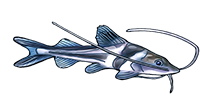Baumgärtner et al. wrote:ABSTRACT
The karyotype and chromosomal characteristics of , a representative of the South American catfish family Doradidae, were analyzed by conventional (Giemsa staining, silver staining, C-banding) and molecular (FISH with rDNA and telomeric probes) cytogenetic techniques. The diploid chromosome number was 2n = 56, with 36 metacentric, 16 submetacentric, and 4 subtelocentric chromosomes in both sexes; however, a remarkable heteromorphism in pair 22 (submetacentric and metacentric elements) was detected in 6 individuals. Compared to other representatives of Doradidae which mostly have 58 chromosomes, the karyotype of T. paraguayensis suggests a reduction in 2n due to chromosomal fusion, as could be deduced from the presence of an interstitial telomere sequence in the submetacentric pair 19. Pale heterochromatic blocks were present in the terminal regions of some chromosomes, very similar to other species of Doradidae. The interstitial position of the NORs observed in the karyotype of T. paraguayensis differs from those reported for most Doradidae species, indicating that it is a derived character. FISH with 5S rDNA revealed 2 interstitial fluorescent signals in the submetacentric pair 22, and the polymorphism of these sites likely resulted from a pericentric inversion.
Cytogenetics of Trachydoras paraguayensis
- bekateen
- Posts: 9650
- Joined: 09 Sep 2014, 17:50
- I've donated: $40.00!
- My articles: 4
- My images: 143
- My cats species list: 146 (i:106, k:34)
- My aquaria list: 37 (i:14)
- My BLogs: 44 (i:154, p:2563)
- My Wishlist: 36
- Spotted: 184
- Location 1: USA, California, Stockton
- Location 2: USA, California, Stockton
- Contact:
Cytogenetics of Trachydoras paraguayensis
Baumgärtner L., Paiz L.M., Margarido, V.P., & Portela-Castro, A.L.B. 2016. Cytogenetics of the Thorny Catfish Trachydoras paraguayensis (Eigenmann & Ward, 1907), (Siluriformes, Doradidae): Evidence of Pericentric Inversions and Chromosomal Fusion. Cytogenet Genome Res, DOI:10.1159/000448126.
Find me on YouTube & Facebook: http://youtube.com/user/Bekateen1; https://www.facebook.com/Bekateen
Buying caves from https://plecocaves.com? Plecocaves sponsor Bekateen's Fishroom. Use coupon code bekateen for 15% off your order. Also, for you Swifties: Https://youtu.be/ZUKdhXL3NCw





